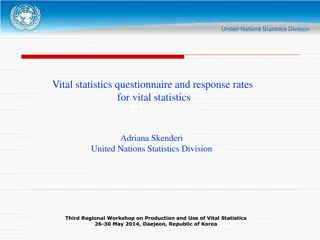Understanding Statistics in ScotPHO Profiles
This presentation provides a clear guide to the statistics used in ScotPHO profiles, covering means, confidence intervals, significance, crude rates, age-sex standardized rates, and life expectancy. It explains concepts like calculating means, interpreting confidence intervals, and determining significance in indicators, making statistical information more accessible.
Download Presentation

Please find below an Image/Link to download the presentation.
The content on the website is provided AS IS for your information and personal use only. It may not be sold, licensed, or shared on other websites without obtaining consent from the author. Download presentation by click this link. If you encounter any issues during the download, it is possible that the publisher has removed the file from their server.
E N D
Presentation Transcript
A guide to the statistics used in the ScotPHO profiles
Introduction This presentation aims to provide a clear, simple guide to the statistics used in the ScotPHO profiles The following topics are covered: - Means - Confidence intervals - Significance - Crude rates - Age-sex standardised rates - Life expectancy
Means This is the average of a set of values It is calculated by adding together the values of the observations in a set, then dividing this by the number of observations in the set. Example: A set of test scores by 6 students: 2,3,5,7,9,10 Mean = = = 6 For example, in the profiles, the average tariff score of all pupils on the S4 roll is calculated in this way
Confidence intervals 1 Every measurement will have an associated uncertainty due to a number of reasons (error, bias, chance, confounding, etc.), meaning that there is always some inaccuracy in each measurement. A confidence interval provides an estimated range of possible outcomes of the measurement, which gives us some idea of how uncertain we are about the measurement. A 95% confidence interval implies that if we were to repeat the same measurement many times, 95% of values would fall within the defined range. It follows that there is a 5% chance that the true value will fall outside the defined range.
Confidence intervals - 2 In this example, the red shaded area indicates the range of the 95% confidence interval. 5% chance that true value could fall into these areas This is the given true value, but could fall anywhere within the red area It should be noted that it extends in both directions from the given value, i.e. the true value may be higher or lower than the measured value. This is referred to as a double-sided confidence interval. So if an indicator had a lower confidence limit of 9 and an upper confidence limit of 15, we would be 95% sure that the true value was somewhere between 9 and 15.
Confidence intervals - 3 Confidence intervals can be seen in the profiles in 2 places: rank charts and trend charts The whiskers around the given value are the confidence intervals Note that generally, smaller geographical areas will have wider confidence intervals
Significance - 1 In the profiles, we describe indicators as significantly worse , better or not significantly different from their comparators. We find out whether an indicator is significantly different by comparing the confidence intervals of the 2 measurements and looking to see whether they overlap.
Significance- 2 Say that using our 95% confidence intervals described previously, the rates for people actively travelling to work are as follows: The rates for Shetland do not overlap with the rates for either Glasgow or Aberdeen; so we say that the rates of people actively travelling to work in Shetland is significantly different from the rates in Glasgow and Aberdeen. However, the rates for Glasgow and Aberdeen do overlap, so we say that they are not significantly different.
Crude rates - 1 In order to provide a comparison between different areas, it is useful to produce a rate per unit of population, usually per 100,000 people, over a given period of time (e.g. per year). This is calculated by dividing the number of incidents that have been measured by the population, and then multiplying by 100,000. Fictitious example: There were 17 skiing accidents in Scotland in 2008. Crude rate = x 100,000 = x 100,000 = 0.33 incidents per 100,000 people per year
Crude rates - 2 Crude rates are used when you want to take into account the population of an area (because you think it might have an impact on the indicator) In the profiles, indicators which use crude rates include crime rate, teenage pregnancies and live births.
European age-sex standardised rates While crude rates are useful, they do not take into account the difference in demographics between areas. For example, an area with an older population is likely to have a higher rate of deaths, so a comparison with an area with a younger population will be biased. In order to ensure that the rates are a fair comparison, a standard population can be used. The European Standard Population is intended to represent the average demographic make-up of the EU. When standardising, you can look at age alone or age and sex. E.g. when looking at deaths, you would want to standardise by sex too as generally female life expectancy is higher than that of males. The EASR is calculated by taking the crude rate for each age and sex group, then multiplying this by the population in each age (and sex) group in the European Standard Population.
European Age Standardised Rates This fictitious example shows the number of skiing accidents in 2008 (listed in the orange cases column). The Scottish population in 2008 is listed in the yellow column Stage 1 - multiply the age spec rate (which is the crude rate for each age group) by the European Standard Population Stage 2 - add up these results Stage 3 - divide by 100,000 This gives us the EASR. EASR = 0.39 per 100,000 per year. Comparing this with the crude rate of 0.33 from the crude rates example shows that demographics do have an impact, and EASR s are a useful way to deal with them.
Life expectancy Life expectancy is defined as an estimate of the number of years a newborn baby would survive if they experienced the area s age specific mortality rates throughout their life. However the actual life expectancy of a person will change as they move areas, and as they survive different stages of life. Life expectancy is calculated using information including deaths and mid-year population estimates. A life-table is used to perform the statistical analysis. Further information is available from the profiles technical reports and the ScotPHO life expectancy pages: http://www.scotpho.org.uk/population-dynamics/healthy-life- expectancy/references
Summary - the average of a set of values Means - show the range of possible values and a certainty that the true value falls within them Confidence intervals - Significance whether the confidence intervals of 2 values overlap or not - a rate that takes into account the population of an area Crude rates - a rate that takes into account the age (and sometimes sex) make-up of a population Standardised rates - the number of years a newborn baby would be expected to live in a specific area Life expectancy
Further information Profiles - further information on the statistics used in the profiles and how they are calculated can be found in the profiles technical report Association of Public Health Observatories (APHO) - there is further information on all of the statistics described above from the APHO website: http://www.apho.org.uk/resource/item.aspx?RID=48457























